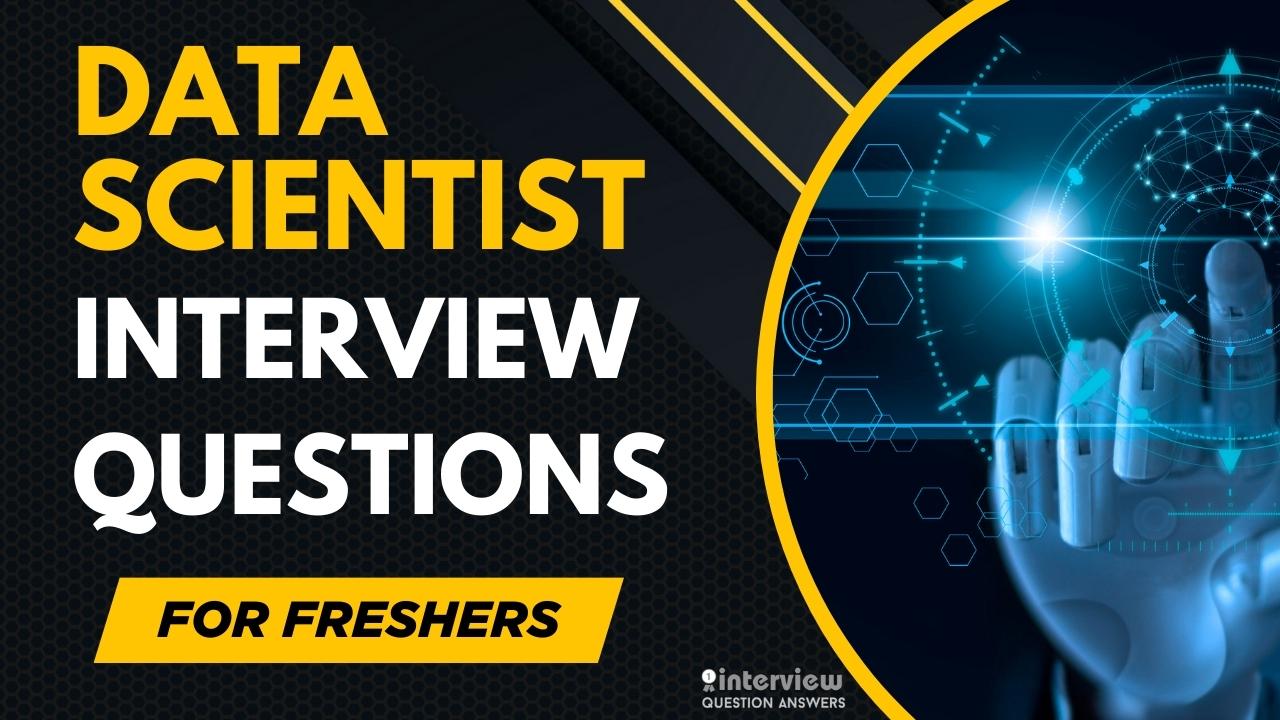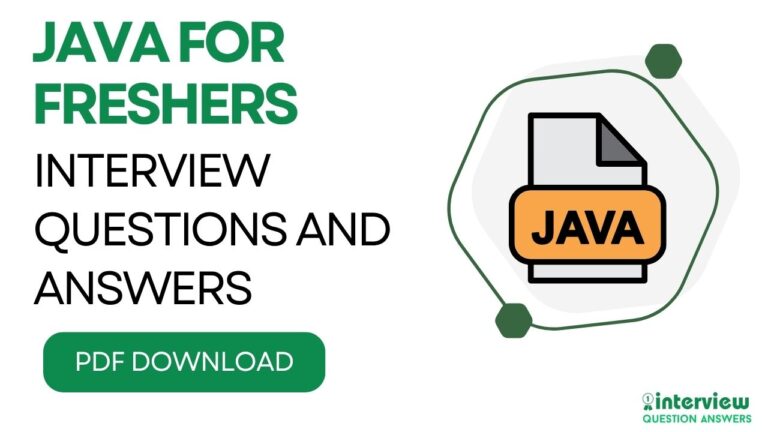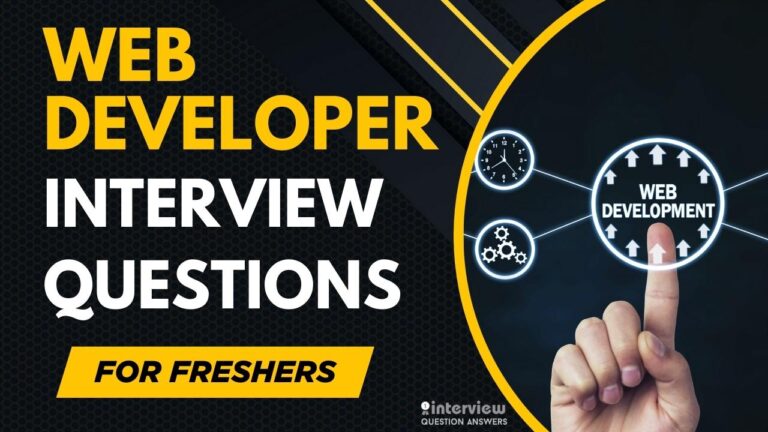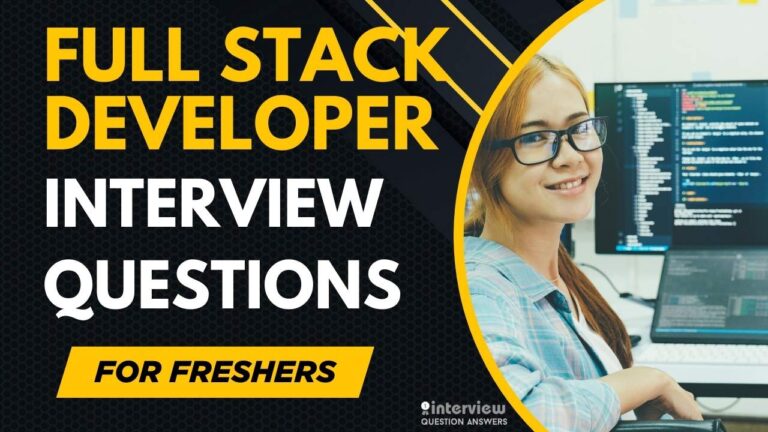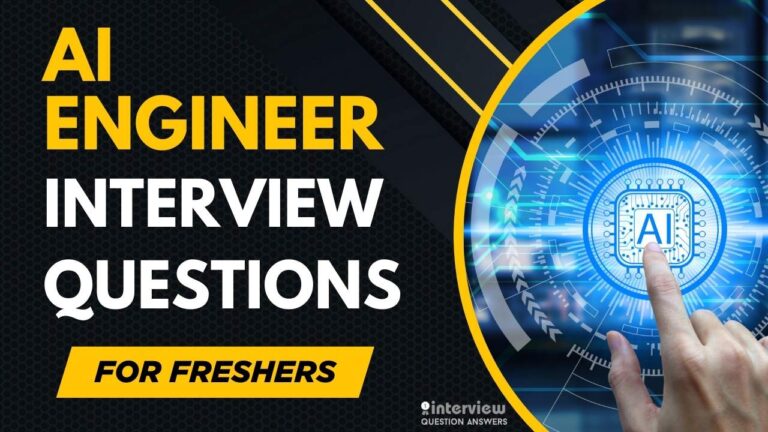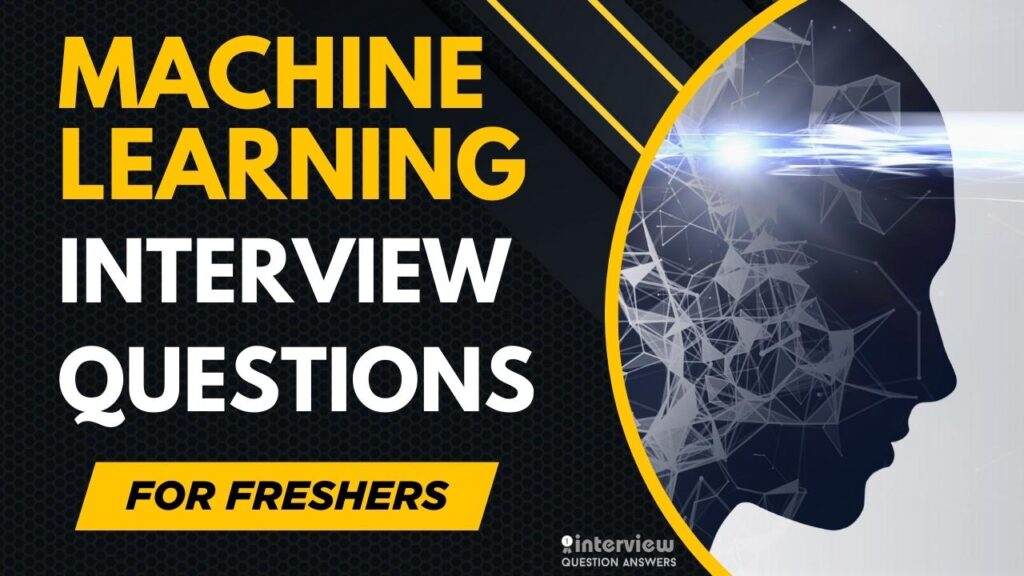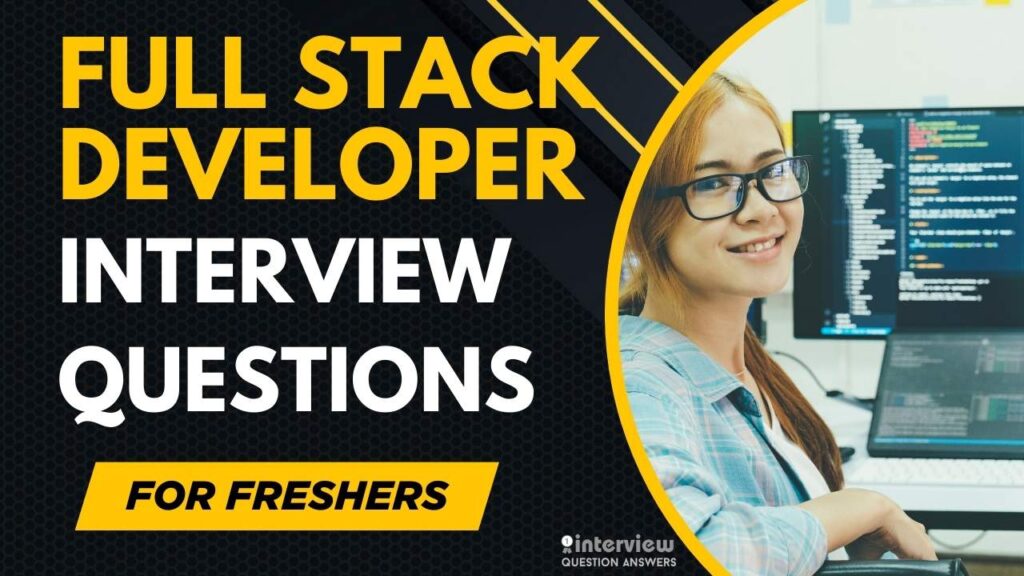Top 50 Data Scientist Interview Questions for Freshers 2025
Data Scientist Interview Questions for Freshers focus on core concepts including machine learning algorithms, statistical analysis, and programming proficiency that entry-level candidates must demonstrate.
Breaking into data science as a fresher requires mastering both technical fundamentals and problem-solving methodologies that employers seek. This comprehensive guide covers Data Scientist Interview Questions for Freshers seeking their first role in this competitive field, addressing Python programming, data preprocessing, model evaluation, and business case studies.
These Data Scientist Interview Questions for Freshers will help you showcase your analytical thinking, technical skills, and readiness to tackle real-world data science challenges in today’s market.
You can also check our in-depth interview guide here: Data Scientist Interview Questions PDF
Basic Data Scientist Interview Questions for Freshers
Que 1. What is the role of a Data Scientist?
Answer: A Data Scientist analyzes data to uncover insights, builds predictive models, and supports decision-making using statistical and machine learning techniques. They use tools like Python, R, and SQL to process data, create visualizations, and communicate findings to stakeholders. For freshers in 2025, understanding business context and basic modeling is key.
Que 2. What is the difference between Data Science and Data Analytics?
Answer:
| Aspect | Data Science | Data Analytics |
|---|---|---|
| Focus | Predictive models, algorithms | Descriptive insights |
| Tools | Python, R, TensorFlow | Excel, SQL, Tableau |
| Scope | Future predictions | Historical trends |
Data Science builds models; Data Analytics summarizes data.
Que 3. What is supervised learning, and can you give an example?
Answer: Supervised learning trains models on labeled data to predict outcomes. Example: Predicting house prices (regression) using features like size and location with known prices as labels.
Que 4. What is unsupervised learning, and when is it used?
Answer: Unsupervised learning finds patterns in unlabeled data, used for clustering or dimensionality reduction. Example: Grouping customers by purchasing behavior using k-means clustering.
Que 5. What is a dataset, and why is data quality important?
Answer: A dataset is a collection of data used for analysis. Data quality (accuracy, completeness) is critical because poor data leads to unreliable models and insights.
Que 6. How do you handle missing data in a dataset?
Answer: Handle missing data by:
- Removing rows/columns with missing values.
- Imputing with mean, median, or mode.
- Using models like KNN for imputation.
For freshers, tools like pandas’fillna()are practical.
Que 7. What is SQL, and how is it used in Data Science?
Answer: SQL (Structured Query Language) queries databases to extract and manipulate data. Data Scientists use it to prepare datasets for analysis.
Example:
SELECT customer_id, SUM(purchase_amount) FROM orders GROUP BY customer_id;Que 8. What is Python’s pandas library, and how is it used?
Answer: Pandas is a Python library for data manipulation, used for filtering, grouping, and merging datasets.
Example:
import pandas as pd
df = pd.read_csv('data.csv')
print(df.groupby('category')['sales'].sum())Que 9. What are descriptive statistics, and what are common measures?
Answer: Descriptive statistics summarize data with:
- Mean: Average value.
- Median: Middle value.
- Standard Deviation: Data spread.
For freshers, calculating these in Python or Excel is essential.
Que 10. What is data visualization, and why is it important?
Answer: Data visualization uses charts or graphs to present data insights clearly. It’s important for communicating findings to stakeholders, using tools like Tableau or matplotlib.
Que 11. How do you create a basic plot in Python using matplotlib?
Answer: Use matplotlib’s plot() or scatter() to visualize data.
Example:
import matplotlib.pyplot as plt
plt.plot([1, 2, 3], [4, 5, 6])
plt.show()Que 12. What is a primary key in a database?
Answer: A primary key uniquely identifies each record in a table, ensuring no duplicates and enabling efficient queries. For freshers, it’s key for joining tables.
Que 13. What is the difference between overfitting and underfitting in machine learning?
Answer: Overfitting occurs when a model learns noise in training data, performing poorly on new data. Underfitting occurs when a model is too simple to capture patterns. For freshers, balancing model complexity is crucial.
Que 14. How do you write a basic SQL JOIN query?
Answer: A JOIN combines data from two tables based on a key.
Example:
SELECT a.name, b.order_date FROM customers a INNER JOIN orders b ON a.id = b.customer_id;Que 15. What is the purpose of data normalization in machine learning?
Answer: Normalization scales features to a standard range (e.g., 0-1) to ensure equal contribution to models, improving performance in algorithms like gradient descent.
Que 16. How do you calculate the mean in Python using pandas?
Answer: Use pandas’ mean() method.
Example:
import pandas as pd
df = pd.DataFrame({'values': [1, 2, 3]})
print(df['values'].mean()) # Outputs: 2.0Que 17. What is a confusion matrix, and what does it show?
Answer: A confusion matrix shows a model’s performance, with counts of true positives, true negatives, false positives, and false negatives. It’s used to evaluate classification models.
Que 18. What is the purpose of the GROUP BY clause in SQL?
Answer: GROUP BY groups rows by column values for aggregation.
Example:
SELECT department, COUNT(*) FROM employees GROUP BY department;Que 19. How do you handle categorical variables in machine learning?
Answer: Encode categorical variables using:
- One-hot encoding (pandas’
get_dummies()). - Label encoding for ordinal data.
For freshers, one-hot encoding is common for nominal data.
Que 20. What is a histogram, and how do you create one in Python?
Answer: A histogram shows the distribution of numerical data. Create it with matplotlib’s hist().
Example:
import matplotlib.pyplot as plt
data = [1, 2, 2, 3, 4]
plt.hist(data, bins=5)
plt.show()Que 21. What is the difference between correlation and causation?
Answer: Correlation measures the relationship between variables (e.g., via Pearson’s coefficient), while causation implies one causes the other. For freshers, avoiding causation assumptions without evidence is critical.
Que 22. How do you split a dataset into training and testing sets in Python?
Answer: Use scikit-learn’s train_test_split().
Example:
from sklearn.model_selection import train_test_split
X, y = df[['feature']], df['target']
X_train, X_test, y_train, y_test = train_test_split(X, y, test_size=0.2)Que 23. What is a p-value in statistical testing?
Answer: A p-value measures the probability of observing data under the null hypothesis. A low p-value (e.g., <0.05) suggests evidence to reject the null. For freshers, interpreting p-values is key for hypothesis testing.
Que 24. How do you perform a basic linear regression in Python?
Answer: Use scikit-learn’s LinearRegression.
Example:
from sklearn.linear_model import LinearRegression
model = LinearRegression()
model.fit(X_train, y_train)
predictions = model.predict(X_test)Que 25. What is the purpose of cross-validation in machine learning?
Answer: Cross-validation evaluates a model’s performance by splitting data into multiple folds (e.g., k-fold), training on subsets, and testing on others. It reduces overfitting and ensures robust performance. For freshers, k=5 is a common choice.

Also Check: Data Scientist Interview Questions for Experienced
Advanced Data Scientist Interview Questions for Freshers
Que 26. What is the difference between a decision tree and a random forest in machine learning?
Answer:
| Model | Description | Key Feature |
|---|---|---|
| Decision Tree | Single tree-based model | Prone to overfitting |
| Random Forest | Ensemble of multiple trees | Reduces overfitting via averaging |
Random forests improve accuracy by combining predictions from multiple decision trees. For freshers in 2025, understanding ensemble methods is key for robust models.
Que 27. How do you handle imbalanced datasets in classification problems?
Answer: Handle imbalanced datasets by:
- Oversampling the minority class (e.g., SMOTE in Python).
- Undersampling the majority class.
- Using class weights in algorithms like
RandomForestClassifier.
For freshers, applying SMOTE with scikit-learn ensures balanced model training.
Example:
from imblearn.over_sampling import SMOTE
smote = SMOTE()
X_balanced, y_balanced = smote.fit_resample(X, y)Que 28. What is the purpose of feature scaling, and when is it necessary?
Answer: Feature scaling standardizes feature ranges (e.g., via MinMaxScaler or StandardScaler) to ensure equal contribution to models like SVM or neural networks. It’s necessary for gradient-based algorithms but not for tree-based models like random forests.
Que 29. How do you implement k-means clustering in Python?
Answer: Use scikit-learn’s KMeans to group data into clusters based on similarity.
Example:
from sklearn.cluster import KMeans
import pandas as pd
X = pd.DataFrame({'x': [1, 2, 10], 'y': [1, 3, 9]})
kmeans = KMeans(n_clusters=2)
kmeans.fit(X)
print(kmeans.labels_)Que 30. What is the difference between L1 and L2 regularization?
Answer: L1 regularization (Lasso) adds the absolute value of coefficients to the loss function, promoting sparsity. L2 regularization (Ridge) adds the squared value, reducing coefficient magnitude. For freshers, L1 is useful for feature selection, while L2 handles multicollinearity.
Que 31. How do you evaluate a regression model’s performance?
Answer: Evaluate regression models using metrics like:
- Mean Squared Error (MSE): Average squared difference between predictions and actuals.
- R-squared: Proportion of variance explained.
- RMSE: Square root of MSE for interpretability.
For freshers, computing these in scikit-learn is standard.
Example:
from sklearn.metrics import mean_squared_error, r2_score
mse = mean_squared_error(y_test, predictions)
r2 = r2_score(y_test, predictions)Que 32. What is a ROC curve, and how do you interpret it?
Answer: A ROC (Receiver Operating Characteristic) curve plots true positive rate vs. false positive rate for a classifier. The Area Under the Curve (AUC) measures performance; AUC close to 1 indicates a strong model. For freshers, plotting ROC with scikit-learn aids evaluation.
Que 33. How do you handle multicollinearity in a dataset?
Answer: Detect multicollinearity using Variance Inflation Factor (VIF) or correlation matrices. Handle it by:
- Removing highly correlated features.
- Using PCA for dimensionality reduction.
- Applying regularization (e.g., Ridge).
For freshers, checking VIF in Python’s statsmodels is practical.
Que 34. What is the purpose of cross-validation, and how do you implement it?
Answer: Cross-validation assesses model performance by splitting data into k-folds, training on k-1 folds, and testing on the remaining fold. Implement with scikit-learn’s cross_val_score.
Example:
from sklearn.model_selection import cross_val_score
from sklearn.linear_model import LogisticRegression
model = LogisticRegression()
scores = cross_val_score(model, X, y, cv=5)
print(scores.mean())Que 35. How do you perform feature selection in Python?
Answer: Use methods like:
- Filter: Select features by correlation or chi-square.
- Wrapper: Recursive Feature Elimination (RFE).
- Embedded: Lasso regression.
For freshers, RFE with scikit-learn is a common approach.
Example:
from sklearn.feature_selection import RFE
from sklearn.linear_model import LinearRegression
model = LinearRegression()
rfe = RFE(model, n_features_to_select=3)
rfe.fit(X, y)Que 36. What is the bias-variance tradeoff in machine learning?
Answer: The bias-variance tradeoff balances model complexity. High bias (underfitting) misses patterns; high variance (overfitting) captures noise. For freshers, tuning model complexity (e.g., tree depth) achieves optimal performance.
Que 37. How do you create a confusion matrix in Python?
Answer: Use scikit-learn’s confusion_matrix to evaluate classification performance.
Example:
from sklearn.metrics import confusion_matrix
y_true = [1, 0, 1, 1]
y_pred = [1, 1, 1, 0]
cm = confusion_matrix(y_true, y_pred)
print(cm)Que 38. What is principal component analysis (PCA), and when is it used?
Answer: PCA reduces dimensionality by transforming features into orthogonal components, capturing maximum variance. It’s used for high-dimensional data to improve model efficiency or visualization. For freshers, applying PCA with scikit-learn is key.
Que 39. How do you implement a logistic regression model in Python?
Answer: Use scikit-learn’s LogisticRegression for binary or multiclass classification.
Example:
from sklearn.linear_model import LogisticRegression
model = LogisticRegression()
model.fit(X_train, y_train)
predictions = model.predict(X_test)Que 40. What is the purpose of the elbow method in clustering?
Answer: The elbow method determines the optimal number of clusters in k-means by plotting within-cluster sum of squares (WCSS) against cluster count and identifying the “elbow” point where WCSS decreases slowly.
Que 41. How do you handle time series data in Python?
Answer: Use pandas for time series operations like resampling or lagging, and statsmodels for models like ARIMA.
Example:
import pandas as pd
df = pd.DataFrame({'date': pd.date_range('2025-01-01', periods=5), 'value': [10, 20, 30, 40, 50]})
df.set_index('date', inplace=True)
print(df.resample('M').mean())Que 42. What is the difference between precision, recall, and F1-score?
Answer: Precision measures correct positive predictions; recall measures captured positives; F1-score balances both. For freshers, computing these with scikit-learn’s classification_report is standard.
Que 43. How do you encode categorical variables for machine learning?
Answer: Use:
- One-hot encoding for nominal data (pandas’
get_dummies()). - Label encoding for ordinal data (scikit-learn’s
LabelEncoder).
For freshers, one-hot encoding is common for non-ordinal categories.
Que 44. What is gradient descent, and how does it work?
Answer: Gradient descent optimizes model parameters by minimizing a loss function, iteratively adjusting weights using the gradient’s direction. For freshers, understanding learning rate tuning is key.
Que 45. How do you visualize correlations in Python using seaborn?
Answer: Use seaborn’s heatmap() to visualize a correlation matrix.
Example:
import seaborn as sns
import pandas as pd
df = pd.DataFrame({'A': [1, 2, 3], 'B': [4, 5, 6]})
sns.heatmap(df.corr(), annot=True)Que 46. What is the purpose of hyperparameter tuning in machine learning?
Answer: Hyperparameter tuning optimizes model settings (e.g., learning rate) to improve performance, using techniques like grid search or random search in scikit-learn.
Que 47. How do you implement a random forest model in Python?
Answer: Use scikit-learn’s RandomForestClassifier or RandomForestRegressor.
Example:
from sklearn.ensemble import RandomForestClassifier
model = RandomForestClassifier(n_estimators=100)
model.fit(X_train, y_train)Que 48. What is the difference between bagging and boosting?
Answer: Bagging (e.g., random forest) trains models independently and averages predictions to reduce variance. Boosting (e.g., XGBoost) trains models sequentially, focusing on errors to reduce bias. For freshers, understanding ensemble benefits is key.
Que 49. How do you handle outliers in a dataset for machine learning?
Answer: Detect outliers using IQR or z-scores, then:
- Remove outliers if minimal.
- Cap values at thresholds.
- Transform data (e.g., log transformation).
For freshers, using pandas for outlier handling is common.
Que 50. What is A/B testing, and how do you analyze results?
Answer: A/B testing compares two versions to determine which performs better. Analyze results using statistical tests like t-tests to compare metrics (e.g., conversion rate). For freshers, tools like Python’s scipy or Google Optimize simplify analysis.
Conclusion
We have already shared the essential questions for Data Scientist Interview Questions for Freshers. This comprehensive Data Scientist Guide includes interview questions for fresh graduates, covering both basic and advanced concepts that employers commonly evaluate. The data science industry is rapidly evolving with deep learning, MLOps, and automated machine learning becoming standard requirements for entry-level positions.
These Data Scientist Interview Questions for Freshers provide the technical foundation needed to succeed in your job search, covering machine learning algorithms to statistical modeling techniques. With proper preparation using these Data Scientist Interview Questions for Freshers and understanding current industry demands, you’ll be well-positioned to launch your data science career.

